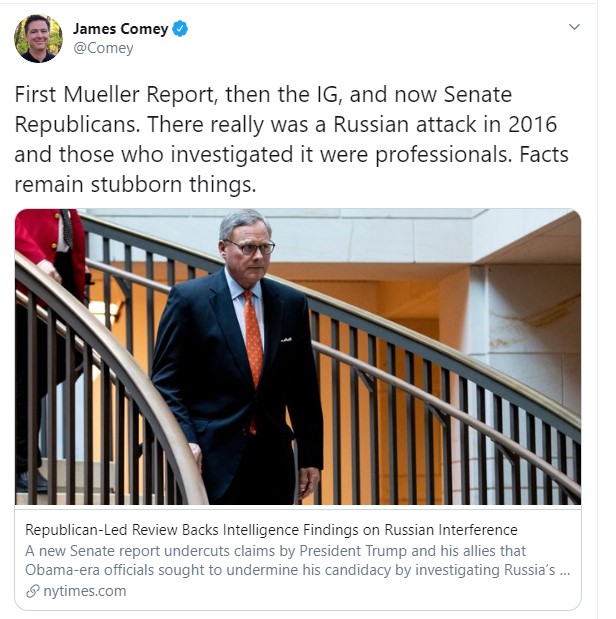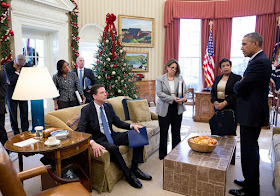A close reading of the report—or at least those portions of the report that could be read—cements the reality that the FBI intentionally snowed the FISA court to spy on Donald Trump.
On April 21, the Senate Select Committee on Intelligence released a report on its review of the Intelligence Community Assessment (ICA) drafted for President Barack Obama on Russia’s interference in the 2016 election.
Corporate media immediately touted the Republican-controlled committee’s finding that “the ICA presents a coherent and well-constructed intelligence basis for the case of unprecedented Russian interference in the 2016 U.S. presidential election,” including by hacking Democratic National Committee emails, as vindication of the intelligence communities’ handling of all things Russia. But a close reading of the report—or at least those portions of the report that could be read—instead cements the reality that the FBI intentionally snowed the FISA court to spy on Donald Trump.
After Trump’s surprise election, then-President Obama directed “CIA Director John Brennan to conduct a review of all intelligence relating to Russian involvement in the 2016 election and produce a single comprehensive assessment.” With Brennan at the helm, the Central Intelligence Agency, National Security Agency, and FBI compiled a report for Obama, which the FBI insisted include the now-discredited Christopher Steele dossier.
Other intelligence leaders objected, and as the committee report explained, the disagreement “was ultimately resolved by including the information as Annex A, a two-page summary attached only to the most classified version of the ICA.” The report explained the NSA was not involved in the discussion or the decision to include the Steele dossier in the annex, but then-FBI Director James Comey insisted that Steele’s “intel” be included, although he “was agnostic as to whether it was footnoted in the document itself, put as an annex.”
Significantly, in tracing this history of the decision to include the Steele dossier in the intel report, the Senate Select Committee on Intelligence noted that “the FBI didn’t want to stand behind” Steele’s reporting.
But the FBI did stand behind Steele reporting to federal Foreign Intelligence Surveillance Act (FISA) court judges four times: once months earlier, and then mere weeks after the FBI opted to only summarize the dossier in the annex to the ICA report because the agents didn’t “want to stand behind” the reporting. As Inspect General Michael Horowitz found, and as the recent additional declassifications of the FISA applications prove, the Steele dossier was indispensable to the FISA surveillance applications. Yet “the FBI didn’t want to stand behind” it!
Nonetheless, and without a hint of self-reflection, Comey has pointed to yesterday’s Senate report as exoneration. Those who investigated Russian interference in the 2016 election “were professionals,” Comey tweeted.

That “the FBI didn’t want to stand behind” the Steele dossier raises the question of why then did the FBI insist on including the details in the report, albeit in the annex? Here, it is helpful to remember that the intelligence community briefed then-president Obama on the report on January 5, 2017 and President-elect Trump on the next day—the same day an unclassified version of the ICA was publicly released.
Less than a week later, on January 12, 2017, “Evan Perez, Jim Sciutto, Jake Tapper, and Carl Bernstein of CNN reported . . . that President-elect Trump was briefed on classified information indicating that the Russians have compromising personal or financial information that the Russians could use against President-elect Trump.” Former Director of National Intelligence James Clapper later admitted “that he confirmed the existence of the dossier to the media.” (CNN later hired Clapper as a national security advisor.)
So maybe the FBI insisted the Steele dossier be included to provide a media hook to report on the tabloid tales Steele weaved together for the Clinton campaign?
Tuesday’s report on the ICA of Russia interference in the 2016 election proves troubling for another reason: There were so many redactions, it is impossible to know what the committee omitted. As we now know from all the unnecessary and damning redactions since declassified in both the IG report and the FISA applications, the hidden details often tell a much different story.
Of particular interest is whether buried beneath the redactions was a discussion of Russia’s potential pushing of disinformation to Steele as a means of interfering with the 2016 election. We know from the declassified footnotes that the FBI received several different tips that Russia was feeding disinformation to Steele.
Did the ICA assessment of Russian interference include an analysis of Russia potentially feeding the Hillary Clinton campaign disinformation? If not, why not? That would be a very glaring error.
Another reason to seek more clarity on the ICA of Russia interference is that Rep. Devin Nunes, R-Calif., has recently been calling out that report as containing either lies, omissions, or both, on Fox News Sunday and last night on Lou Dobbs. It’s one of three dossiers, Nunes explained, with the Steele dossier and the Robert Mueller report being the other two.
Given that Nunes nailed the case of FISA abuse long before the IG issued a report confirming Nunes’s analysis, Nunes’s attacks on the ICA report deserve credence—and the report deserves declassification.

